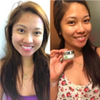Introduction
Different people have different types of hair, and therefore different haircare products are going to produce different results depending on what type of hair you have.
This article is designed to explain the differences between deep, normal and leave in conditioners so that you can easily figure out exactly what suits your specific hair needs.
1. Leave-in conditioner
Just like the name suggests, these are conditioners that are applied and then left on the user’s hair. You should not rinse them away.
A leave in conditioner that suits your hair is useful for controlling frizz, detangling strands and keeping your curls smooth. On the other hand, an overly heavy conditioner can leave your hair looking greasy.
Leave in conditioners are normally light lotions, creams or liquids sprayed onto the user’s hair for easy absorption. Spraying the conditioner is especially effective because it easily reaches certain parts (like the ends of the hair) that need special attention for protection and conditioning to work.
Leave in conditioners work by coating the hair to restore moisture, decreasing friction to prevent breakage, and adding shine. Heat protection sprays are used to prevent the loss of moisture because of heat-styling, while curl boosting sprays are for adding those cool curl patterns, elasticity, bounce, and moisture.
Seals in the Moisture
Many people use conditioners to moisturize their hair, and the importance of maintaining the hair’s moisture level can never be overstated. A leave in conditioner locks the moisture in the hair strands for a longer period than a conditioner that you rinse out or a sulfate-free shampoo.
This means that your hair will remain healthier for longer, and you will avoid hair problems like frizzy, breakage, split ends and dryness.
Eliminates Build Up
Rinse out conditioners and other hair care products normally leave some residue in your hair even after you have rinsed them out; this can weigh down your hair as it builds up over time.
A leave in conditioner is better at avoiding this build up because it rinses away completely when you wash your hair later. This ensures that you get a fresh start every time you use the leave in conditioner.
Some of the leading leave in products include:
- Davines Essential DEDE Hair Mist recommended for people with wispy hair who are trying to develop fine, straight hair.
- Aveda Sun Care Protective Hair Veil, which is used to protect colored hair from ultraviolet rays and replenish the hair with nutrients.
- Green Tea & Calendula Leave-In Conditioning Mist, which is good for natural hair.
2. Normal conditioner
This kind of conditioner is also referred to as a daily, regular, surface or rinse out conditioner.
A normal conditioner usually goes hand-in-hand with shampoo; it should be left on your hair for 1 to 5 minutes before you rinse it out. This conditioner can only impart its ingredients onto your hair surface at a moderate pace.
A normal conditioner’s formulation falls somewhere between that of a deep conditioner and a leave-in conditioner. Most normal conditioners provide the hair with moisture from silicones, humectants, and emollients.
Apart from restoring moisture, they also leave the hair silky, shiny and soft by softening the hair cuticle.
You can use this type of conditioner a few times a week, or even daily because it is quite gentle to your hair and scalp.
3. Deep conditioner
This is a conditioning agent that is specifically formulated to give the hair a very thorough treatment and repair. Products used for deep conditioning include protein packs and hair masques.
Deep conditioners are normally quite thick in consistency and hence take a longer time to produce their effect. You should leave one on your hair for approximately 10 to 30 minutes. The upside to this high viscosity is that the effects of the deep conditioner will last longer compared to those of regular or leave in conditioners.
Most deep conditioners contain oil with good penetrating characteristics (like olive oil, avocado oil or coconut oil). The best have additional ingredients that help penetrate the hair shaft so that they can nourish the hair cuticle on a deeper level.
The rate at which moisture is absorbed into the hair shafts can be increased by using heat during the process of deep conditioning.
Deep conditioners are broken down into two categories: those meant to provide proteins and those primarily for moisture. For the most balanced results, you should use both of them.
Deep conditioners that are protein-based help to improve elasticity, appearance, and strength of the hair. To repair damaged hair, you need to keep up a consistent regimen of protein treatments.
However, the introduction of keratin protein will result in your hair feeling ‘hard’ at first. To neutralize this you must follow up with a moisture-based deep conditioner. This type of deep conditioner is vital for softening the hair as well as keeping it moisturized. Treatments should alternate: For instance, if you perform a protein treatment this week, then you should do a moisturizing treatment next week.
Some of the top deep conditioning products are the Cantu Shea Butter Deep Treatment Masque, SheaMoisture African Black Soap Purification Masque, Eden BodyWorks Jojoba Monoi Deep Conditioner, ApHogee Keratin 2 Minute Reconstructor, Aubrey Organics Honey Suckle Rose, SheaMoisture Raw Shea Butter Deep Treatment Masque, and Aussie 3 Minute Miracle Moist Deep Conditioner.
Conclusion
As you have seen, you can use the different types of conditioners to serve the specific needs of your hair. Don’t be afraid to try a few different conditioners until you find one you really like. Observing the results and how your hair reacts will help you decide which conditioner is for you.
It is important to note that some products might not be compatible with your particular hair. You should stop using any product that irritates your scalp or dries up your hair. And of course, you should always follow the instructions provided by the manufacturer.







 Verified Purchase
Verified Purchase



